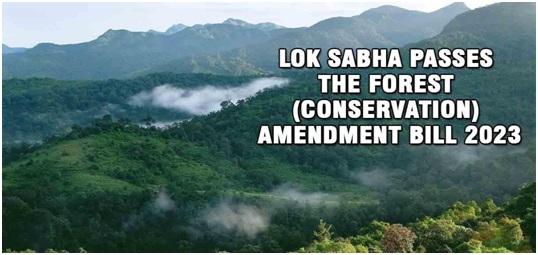The Forest (Conservation) Amendment Bill, 2023 (The Hindu)

- 28 Jul 2023
Why in the News?
Amidst pandemonium, the Lok Sabha passed the Forest Conservation (Amendment) Bill on July 26, without any changes from the version first introduced on March 29. The contentious Bill was introduced to amend the Forest Conservation Act, 1980.
Context:
- The Forest (Conservation) Act, 1980, was enacted to prevent large-scale deforestation and mandates central government approval for diverting forest land for non-forest purposes.
- The pressure on forest land has increased due to various factors like industry demands, agriculture, and the need for forest produce, as noted by the Standing Committee on Science and Technology, Environment, and Forests (2019).
- The Forest (Conservation) Amendment Bill alters the criteria for including and excluding forest land from the Act's scope, presenting modifications to address the evolving challenges faced in forest conservation.
What is The Forest (Conservation) Act 1980?
- The Forest (Conservation) Act of 1980 was implemented to safeguard India's forest land from unauthorized encroachments for non-forestry activities.
- It grants the Central government the authority to demand appropriate compensation when forest land is diverted for non-forestry purposes.
- Furthermore, the Act extends its scope to encompass areas not officially classified as "forest" in State or Central government records.
Need for the recent amendments:
- The process of obtaining forest-clearance approval in India is challenging, involving significant delays and potential corruption.
- Inconsistent land records add to the complexity, as parcels marked as forests in one record may have different classifications elsewhere.
- A court order inadvertently discouraged states from reclassifying forests, complicating matters further.
- The amendments aim to eliminate ambiguities and provide clear guidelines for the Act's application to different types of lands.
Key Features of the Forest (Conservation) Amendment Bill, 2023:
- Land under the Act:
- The Bill includes two categories of land under its purview, including officially declared forest land and land notified as a forest after October 25, 1980.
- Exemptions:
- Certain land types, such as forest land along railways or public roads maintained by the government, are exempted from the Act's provisions.
- Assignment/Leasing of Forest Land:
- Prior approval of the central government is required for assigning forest land to any entity, including those owned and controlled by the government, with specific terms and conditions.
- Permitted Activities:
- The Bill expands the list of activities excluded from non-forest purposes, including zoos, ecotourism facilities, silvicultural operations, and others specified by the central government.
- Power to Issue Directions:
- The central government may issue implementation directions to any recognized authority or organization under the central, state, or union territory.
Upsides of the Forest Amendment Bill:
- Certain amendments outline exclusions where the Act won't apply.
- Other amendments promote plantation cultivation on non-forest land, potentially increasing tree cover, acting as a carbon sink, and supporting India's emissions reduction goals.
- The bill would lift restrictions on infrastructure development for national security and livelihood opportunities for forest-adjacent communities.
Environmentalists' Concerns with the Forest Amendment Bill:
- Changing the Act's name to Van (Sanrakshan Evam Samvardhan) Adhiniyam raises confusion.
- Reclassifying forest areas may invalidate past judgments and reduce protection for vast forest tracts.
- The Bill doesn't consider the real scenario of deforestation and its impact on ecological functions.
- Exemptions in border areas may hinder the rights of forest-dwelling tribes and reduce the necessity of forest clearances.
- The Bill was referred to a joint committee instead of the standing committee, raising concerns about the potential lack of scrutiny.
Government's Intention with the Forest Amendment Bill:
- The government sees this as a crucial opportunity to address a 27-year-old policy deadlock that hinders growth and employment while not effectively conserving forests.
- The amendments are necessary to align with India's evolving ecological, strategic, and economic aspirations. They aim to:
- Support India's objective of increasing forest and tree cover to a third of its land area.
- Help achieve Net Zero emissions by 2070 and enhance forest carbon stocks through sustainable development.
- Create a carbon sink of 2.5-3 billion tonnes of CO2-equivalent by 2030 under the Nationally Determined Contribution targets.
- Enable the act to address emerging ecological challenges related to forest conservation, restoration, compensatory mechanisms, and mitigation measures.
Striking a Balance between Forest Conservation and Economic Activities:
- The 1980 Act aimed to combat deforestation, necessitating central government approval for diverting forest land for non-forest purposes. Additionally, only certain conservation and wildlife management activities were allowed without prior approval.
- The Bill introduces new activities like silvicultural operations, safaris, and eco-tourism facilities to this list. It also permits certain surveys without central government approval.
- These activities can contribute to economic development and align with national priorities such as energy security and industrial growth, especially in cases like mineral prospecting.
- However, achieving a balance between economic benefits and forest conservation is crucial. The shift from case-by-case examination by the central government to a blanket exemption raises questions about the mechanism for striking this balance.
The Forest (Conservation) Amendment Bill, 2023, warrants meticulous examination to reconcile the noble aspirations outlined in its Preamble with the possible detrimental impact of its operative provisions. An inclusive approach encompassing expanded forest definitions, safeguards for delicate ecosystems, and active involvement of forest communities is imperative. Sustainable development should not entail forest degradation, but instead, harmonize efforts to safeguard India's natural legacy for generations to come. Responsible and holistic conservation endeavors are vital to fulfilling India's net-zero carbon commitments and preserving its invaluable ecosystems.
Mains Question:
- Evaluate the Forest (Conservation) Amendment Bill, 2023, considering its impact on forest preservation, sustainability, and environmental concerns. Suggest measures for balancing economic activities with responsible forest conservation to achieve net-zero carbon commitments. (15 M)
